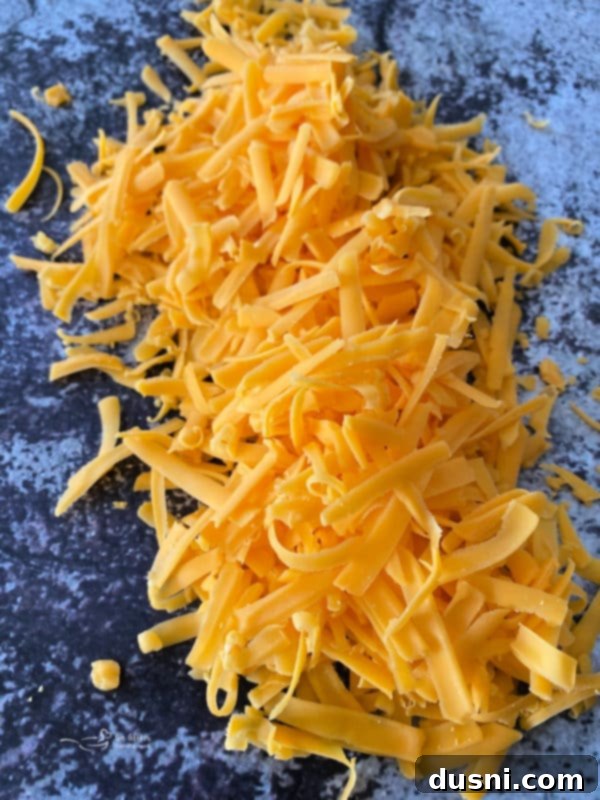Unlock Superior Flavor & Value: The Definitive Guide to Grating Your Own Cheese
Grating your own cheese might seem like an extra step in a busy kitchen, but the truth is, this simple act unlocks a world of superior taste, texture, and undeniable value. Forget the pre-shredded bags that promise convenience but often deliver a compromise. By taking a few moments to grate your own, you’ll discover that your cheese not only melts better and tastes richer, but it also comes free from the unwanted additives that often coat store-bought alternatives. Join us as we delve into the compelling reasons why grating your own cheese is a game-changer for any home cook, explore essential grating tips, and uncover the best tools for the job.

Why Grate Your Own Cheese? The Core Benefits
Many home cooks grab a bag of pre-shredded cheese out of habit, believing it saves time. However, I’m here to persuade you to rethink that shortcut. The minimal effort involved in grating a block of cheese yields significant rewards that impact your cooking, your wallet, and your health. My top three reasons are simple yet profound: it’s more economical, it boasts a superior flavor, and it melts with an unparalleled creaminess. Let’s dive deeper into why making this small change can dramatically elevate your culinary experiences.
Freshly Grated Cheese Tastes Significantly Better
The difference in taste between freshly grated cheese and its pre-shredded counterpart is often astonishing. When you grate cheese from a solid block, you’re experiencing its flavor at its peak, with all its natural aromas and nuances intact. The moment cheese is shredded and packaged, manufacturers face a challenge: how to prevent the shreds from clumping together into a solid block? The answer, for most commercial brands, lies in a common additive you might not even realize is there: cellulose.
Cellulose, often derived from wood pulp, acts as an anti-caking agent. While generally recognized as safe for consumption, it forms a fine, powdery coating on each strand of shredded cheese. This coating, while preventing sticking, also creates a barrier that mutes the cheese’s natural flavor and diminishes its fresh aroma. When you cook with pre-shredded cheese, you’re not just tasting cheese; you’re also tasting that subtle, powdery coating, which can leave a dry, chalky mouthfeel and a less vibrant taste profile. Freshly grated cheese, on the other hand, releases its full, unadulterated flavor, allowing you to truly appreciate the craftsmanship and quality of the dairy product.
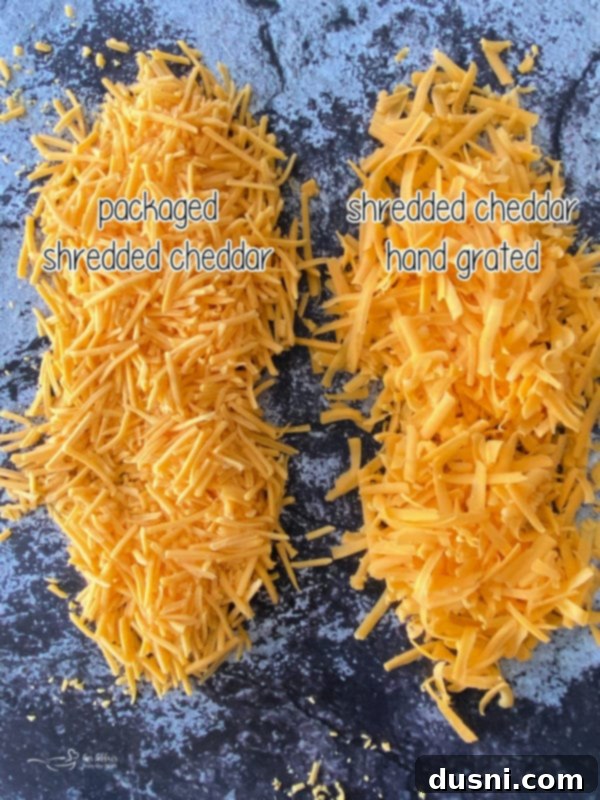
To truly understand the impact of these additives, consider a simple side-by-side comparison. In the image above, you can see the same brand of medium cheddar cheese, with the left side showing pre-packaged shredded cheese and the right side displaying cheese freshly grated from a block. At a quick glance, the differences might seem negligible.
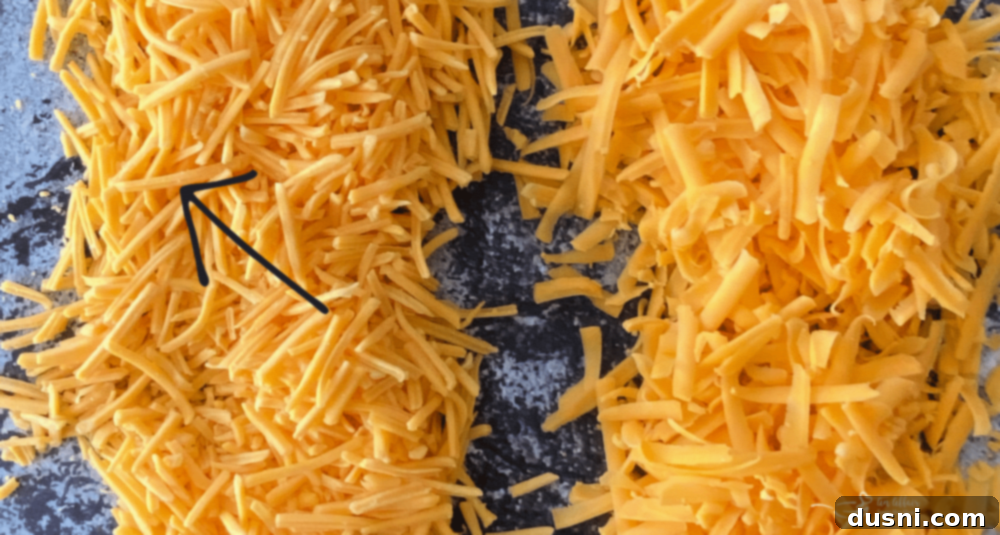
However, if you zoom in, you’ll notice a distinct, almost powdery white coating on the pre-shredded cheese. This is the cellulose and other starches at work, designed to prevent clumping. While it serves its purpose, this coating directly interferes with the cheese’s ability to melt smoothly and deliver its intended flavor. It’s a visual reminder that “convenience” often comes with hidden compromises.

Freshly Grated Cheese Melts Better and More Smoothly
Beyond taste, the melting properties of cheese are crucial for many dishes. This is another area where freshly grated cheese vastly outperforms its pre-shredded counterpart. The cellulose and added starches in bagged cheese don’t just affect flavor; they also inhibit the cheese’s natural ability to melt into a creamy, luxurious consistency. These anti-caking agents create a barrier around each shred, preventing the fat and proteins in the cheese from emulsifying properly when heated. The result is often a greasy, separated, or clumpy mess instead of the smooth, uniform melt you crave.
Think about a classic grilled cheese sandwich, a bubbling pizza, or a rich macaroni and cheese. For these dishes, a perfect, uniform melt is non-negotiable. Freshly grated cheese, free from any coatings, allows the fats to release and the proteins to soften evenly, creating that irresistible stretch and smooth texture known as the “cheese pull.” This superior melt significantly enhances the enjoyment of your food, making every cheesy dish more satisfying and truly delicious.
Grating Your Own Cheese is More Economical
It’s easy to be swayed by the price tag of an 8-ounce bag of pre-shredded cheese versus an 8-ounce block. However, don’t let perceived convenience fool your wallet. In nearly every instance, purchasing a block of cheese and grating it yourself is significantly more economical. You are essentially paying a premium for the “convenience charge” of having someone else do the shredding for you, plus the cost of the extra processing and packaging.
Studies and comparisons frequently show that pre-shredded cheese can cost anywhere from 20% to 50% more per pound than its block equivalent. That might not seem like much for one bag, but over time, these small price differences add up considerably. Furthermore, buying cheese in blocks often allows you to take advantage of sales on larger sizes, further increasing your savings. By choosing block cheese, you’re not just getting a better product; you’re also making a smarter financial decision for your kitchen budget.
Unlock a World of Cheese Options and Purer Flavor
When you opt for pre-shredded cheese, you’re severely limiting your culinary horizons. Most commercially shredded varieties stick to a handful of popular, generic options like mild cheddar, mozzarella, or a “taco blend.” But the world of cheese is vast and wonderfully diverse! Did you know there are hundreds of distinct types of cheese, each with its own unique flavor profile, texture, and melting characteristics? From nutty Gruyère and tangy Gouda to sharp provolone and earthy fontina, the possibilities are endless.
Grating from a block allows you to explore this incredible variety. You can choose specific cheeses for specific dishes, combine different types to create complex flavor layers, or even discover specialty cheeses that are simply never sold pre-shredded. This freedom of choice not only enhances your cooking but also deepens your appreciation for artisanal foods. Moreover, those preservatives and anti-caking agents that compromise melt quality also actively hinder the authentic depth of flavor. When I enjoy cheese, I want to experience its true essence, exactly as the cheesemaker intended, without any chemical interference or masked notes. Freshly grated cheese provides that pure, unadulterated taste experience every time.
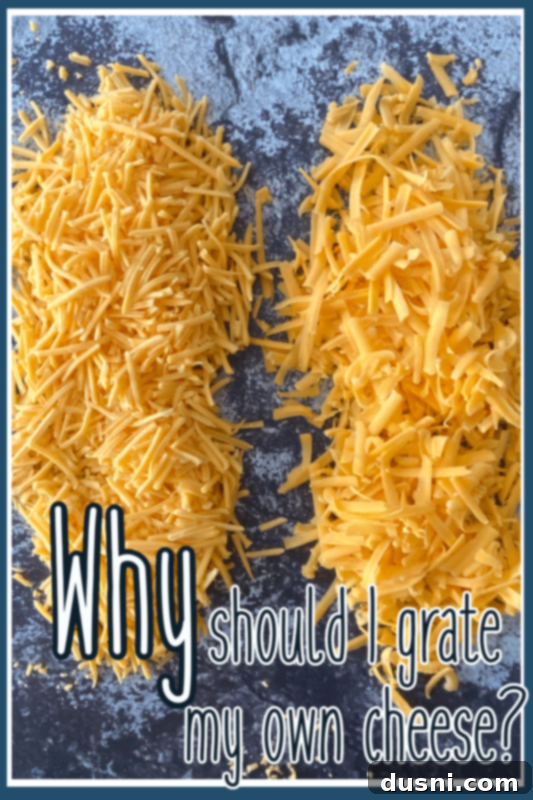
Pin This Informative Guide to Grating Your Own Cheese!
Before you move on to our practical tips, be sure to save this post to your favorite Pinterest board. That way, you’ll always have these valuable insights and recommendations readily available when you need them most!
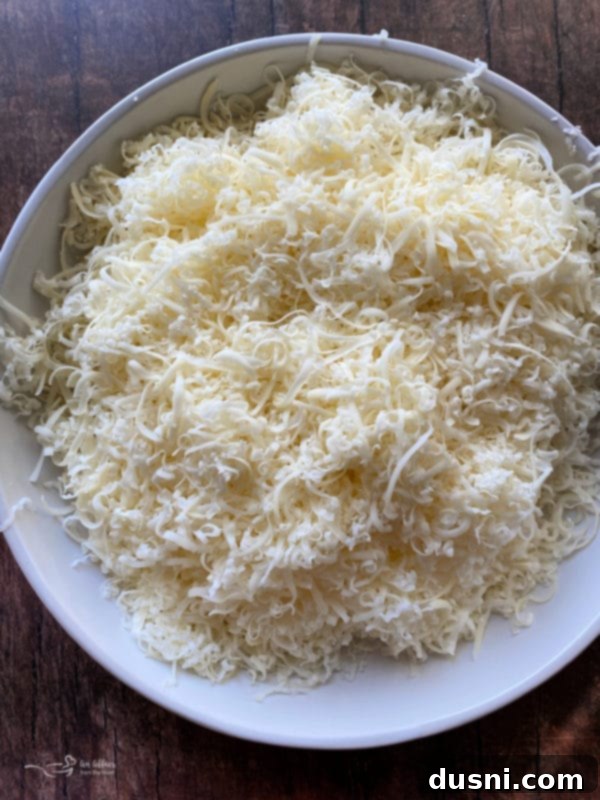
Essential Cheese Grating Tips for Perfect Shreds
Grating cheese might seem straightforward, but a few simple tips can make the process easier, safer, and yield better results. First, you don’t need Herculean strength to grate cheese effectively. The key is to let the sharp blades of your grater and the natural weight of the cheese do most of the work. Hold the block firmly but not aggressively, applying steady, even pressure as you glide it down the grating surface. This technique prevents unnecessary strain and ensures uniform shreds.
Another useful trick is to slightly chill your cheese before grating, especially softer varieties like mozzarella or Monterey Jack. A colder block of cheese will be firmer and less prone to sticking and clumping, making the grating process much cleaner and more efficient. For safety, always be mindful of your fingertips, especially as the cheese block gets smaller. Many graters come with safety guards, or you can use a clean kitchen towel to protect your hand.
Next, using the right blade for the job is paramount. Most box graters offer at least three distinct grating surfaces:
- Fine Holes: These small, sharp holes are perfect for hard cheeses like Parmesan, Pecorino Romano, or even nutmeg. They produce a very fine, almost powdery shred ideal for garnishing pasta, salads, or adding delicate flavor.
- Medium Holes: This is your go-to for most versatile applications. The medium-sized holes create a consistent, even shred that melts beautifully and quickly. It’s excellent for cheddar, mozzarella, Swiss, and other semi-hard cheeses in casseroles, tacos, or macaroni and cheese.
- Coarse Holes: For larger, thicker shreds, opt for the coarse side. This is ideal when you need a substantial amount of cheese for dishes like lasagna, gratins, or topping pizzas where you want a more robust texture and a slower, bubbly melt.
Understanding these distinctions will empower you to select the perfect texture for any recipe, further enhancing your culinary creations.
Types of Cheese Graters: Finding Your Perfect Tool
With a clearer understanding of the benefits and techniques, let’s explore the various types of cheese graters available. The “best” grater often depends on the type of cheese you’re grating, the quantity, and your personal preference for effort and speed. Here are some popular and effective options:
- Four-Sided Stainless Steel Upright Cheese Grater: This is the classic workhorse of many kitchens. Its versatile design typically includes fine, medium, coarse, and sometimes slicing blades on its four sides, making it suitable for a wide range of cheeses and applications. It’s sturdy and provides good leverage.
- Rotary Cheese Grater: Ideal for grating hard cheeses like Parmesan directly onto plates at the table, or for small quantities. These graters typically feature a drum that you turn with a crank, pressing the cheese against the grater. They are often less messy and provide a consistent, fine shred.
- Manual Rotary Cheese Grater with Interchangeable Blades: An upgraded version of the basic rotary grater, these often come with multiple drums for different shred sizes, allowing for more versatility. They are great for grating larger quantities of cheese more quickly and with less effort than a traditional box grater.
- Shredder Attachment for Kitchenaid Stand Mixer: For those who grate large quantities of cheese regularly, a stand mixer attachment is a true time-saver. It automates the process, allowing for hands-free shredding and significantly reducing the physical effort, making it perfect for meal prep or large family meals.
- Flat Stainless Steel 3-in-1 Grater (or Paddle Grater): These simple, compact graters typically offer fine, medium, and sometimes coarse holes on a single flat surface. They are excellent for grating small amounts of cheese quickly, for zesting citrus, or for grating ginger. Their slim design makes them easy to store.
- Hand-Held Graters (Microplane style): While often used for zesting, microplane-style graters are fantastic for creating ultra-fine, fluffy shreds of hard cheese like Parmesan, which literally melts into your dish. They are precision tools for adding a delicate touch of flavor.
No matter which grater you choose, investing in a good quality tool will make the process enjoyable and efficient, encouraging you to embrace the benefits of freshly grated cheese.
Cheesy Recipes We Absolutely Love
Of course, as a recipe site, we couldn’t discuss the wonders of cheese without sharing some of our absolute favorite cheesy recipes! Using freshly grated cheese in these dishes will undoubtedly elevate them, delivering unparalleled flavor and that perfect, creamy melt. You’ll truly taste the difference and understand why this small effort is so rewarding. Get ready to indulge in some seriously delicious, cheese-filled creations!
- Philly Cheese Steak Soup (pictured above)
- Swiss Cheese Dip
- Beer Cheese Sauce
- Arancini (Three Cheese Fried Risotto Balls)
- Summer Sausage Cheese Ball
- Four Cheese Roasted Garlic Bread
- Bacon & Swiss Quiche
- Philly Cheese Steak Stuffed Peppers
- Sausage Pretzel Bombs with Mustard Cheese Sauce
- Texas Trash Dip

Keeping Your Freshly Grated Cheese Fresh
One of the main advantages of grating your own cheese is avoiding preservatives. However, this also means your freshly grated cheese will naturally have a shorter shelf life than its store-bought, additive-laden counterparts. If you find yourself with more grated cheese than you immediately need, proper storage is key to maintaining its quality and preventing spoilage.
For refrigeration, store freshly grated cheese in an airtight container or a heavy-duty freezer bag, squeezing out as much air as possible before sealing. Adding a small piece of paper towel to the container can help absorb any excess moisture, further extending its freshness. Keep it in the coldest part of your refrigerator and aim to use it within three to five days. Always give it a quick visual check and sniff test before using – any signs of mold or an off-smell mean it’s time to discard it.
If you need to store it for a longer period, freezing is an excellent option. To prevent clumping in the freezer, spread your freshly grated cheese in a single layer on a parchment-lined baking sheet and freeze for about 30 minutes to an hour, or until individually frozen. Then, transfer the frozen shreds to an airtight freezer bag or container. When properly stored this way, grated cheese can keep well for up to one month. While still safe to eat beyond that, its quality might start to decline. Keep in mind that frozen and thawed cheese is best used in cooked dishes, as its texture may become slightly crumbly, making it less ideal for raw applications.

In conclusion, while the allure of pre-packaged convenience is understandable in our fast-paced lives, the advantages of grating your own cheese are simply too compelling to ignore. The superior taste, the impeccably smooth melt, the significant cost savings, and the freedom from unnecessary additives all contribute to a far more rewarding culinary experience. It’s a small change with a monumental impact on your cooking. So, the next time you’re at the grocery store, reach for that beautiful block of cheese. Your taste buds, your wallet, and your dishes will thank you. You truly can’t beat the freshness and quality of cheese grated right in your own kitchen! 

